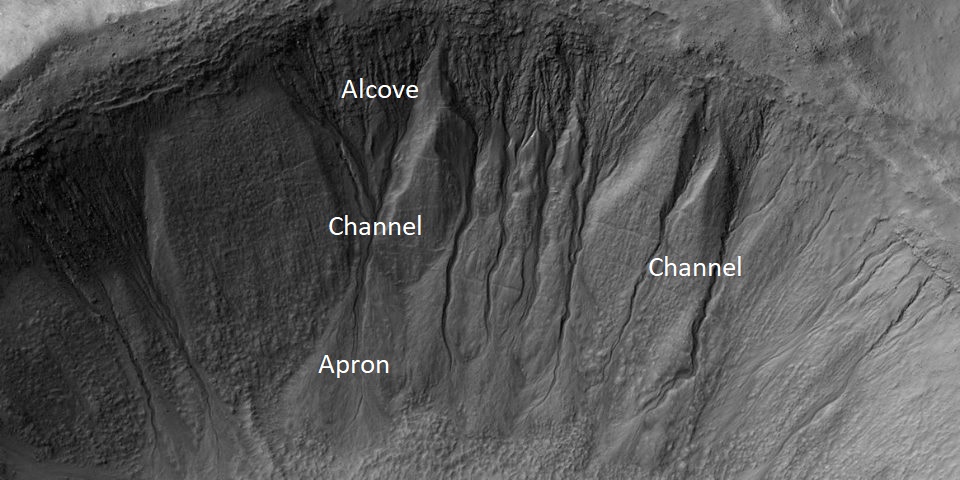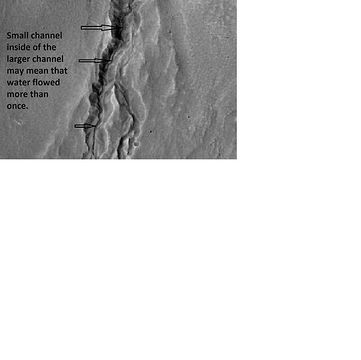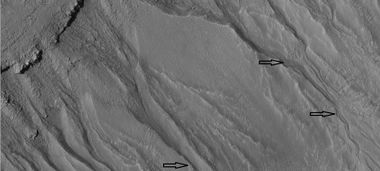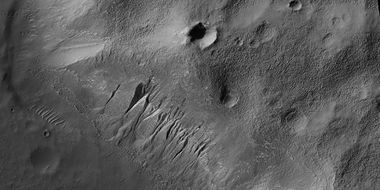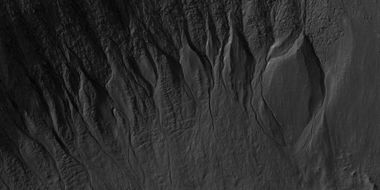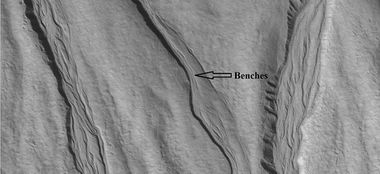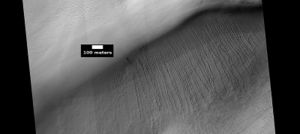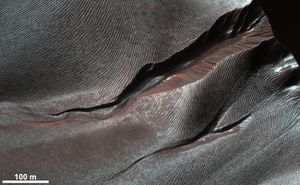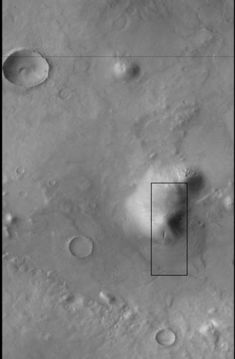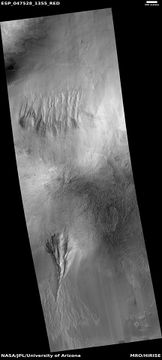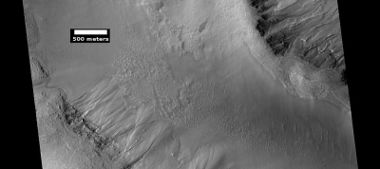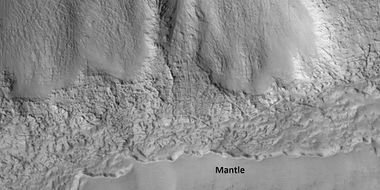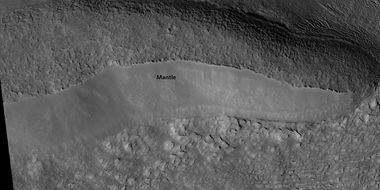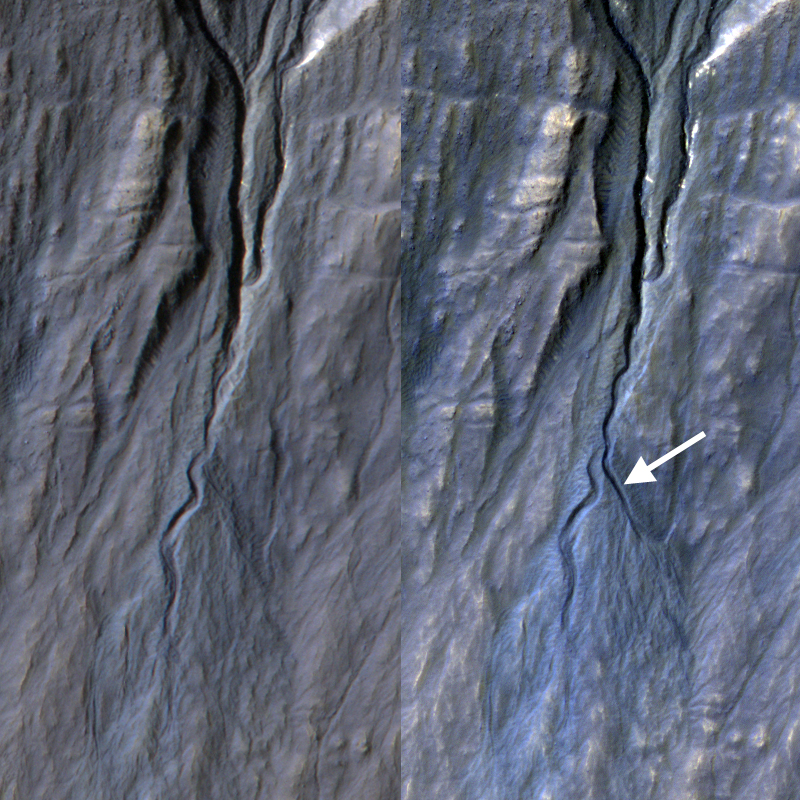Martian gullies
Martian gullies are narrow channels and their associated downslope sediment deposits, they are found on steep slopes on Mars. They were first discovered on Mars Global Surveyor images especially on the walls of craters. Usually, each gully has a ‘‘alcove’’ at its head, a fan-shaped apron at its base, and a single thread of incised channel connecting the two. The whole gully resembles an hourglass. [1] They are estimated to be relatively young because they have few, if any, craters.
Most gullies appear 30 degrees poleward in each hemisphere, with greater numbers in the southern hemisphere. Some studies have found that gullies occur on slopes that face all directions.
[2] Others have found that the greater number of gullies are found on poleward facing slopes, especially from 30° to 44° S.[3] Although thousands of gullies have been found, they appear to be restricted to only certain areas of the planet. In the northern hemisphere, they have been found in Arcadia Planitia, Tempe Terra, Acidalia Planitia, and Utopia Planitia. [4] In the south, high concentrations are found on the northern edge of Argyre basin, in northern Noachis Terra, and along the walls of the Hellas outflow channels.[5] A recent study examined 54,040 CTX images that covered 85% of the Martian surface found 4861 separate gullied landforms (e.g., individual craters, mounds, valleys, etc.), which totaled tens of thousands of individual gullies. This number may represent a fairly accurate census of gullies since it is estimated that CTX can resolve 95% of gullies. [6]
On the basis of their form, aspects, positions, and location amongst and apparent interaction with features thought to be rich in water ice, many researchers think (especially when they were first discovered) that the processes carving gullies involve liquid water.[7] Because the gullies are so young, this would suggest that liquid water has been present on Mars in its very recent geological past, consequently adding to the possibility of living forms on the present surface.
After being discovered, many hypotheses were put forward to explain the gullies. [8] However, as in the usual progression of science, some ideas came to be more plausible than others when more observations were made, when other instruments were used, and when statistical analysis was employed. Even though some gullies resembled debris flows on Earth, it was found that many gullies were on slopes that were not steep enough for typical debris flows. Although it was suggested that liquid carbon dioxide could cause gullies, calculations showed that the pressure and temperatures were not suitable for liquid carbon dioxide. [9] [10] [11] Moreover, the winding shape of the gullies suggested that the flows were slower than what would be produced in debris flows or eruptions of liquid carbon dioxide. Liquid carbon dioxide would explode out of the ground in the thin Martian atmosphere. Because the liquid carbon dioxide would throw material over 100 meters, the channels should be discontinuous, but they are not. [12] Eventually, most hypotheses focused on liquid water coming from an aquifer, from melting at the base of old glaciers (or snowpacks), or from the melting of ice in the ground when the climate was warmer.[13] [14] [15] [16] Close-up images with HiRISE showed details that support the idea that a fluid was involved. Images show that channels formed at various times--smaller channels were found in larger valleys, suggesting that after a valley formed another formed at a later time. Many cases showed channels took different paths at different times. Streamlined forms like teardrop-shaped islands were common in some channels. On the Earth, running water is the cause of streamlined forms.[17]
The following group of pictures of gullies illustrates some of the shapes that lead researchers to think that water was involved in creating at least some of the gullies.
Close-up of gully channels, as seen by HiRISE under HiWish program. This image shows many streamlined forms and some benches along a channel. These features suggest formation by running water. Benches are usually formed when the water level goes down a bit and stays at that level for a time. Location is the Mare Acidalium quadrangle.
Contents
Aquifers
One of the earliest ideas attempting to explain gully formation was that water came out of aquifers. Most of the gully alcove heads occur at the same level, just as one would expect if water came out of aquifers. The aquifer layer would be perched on top of another layer that prevents water from going down (in geological terms it would be called impermeable). Because water in an aquifer is prevented from going down, the only direction the trapped water can flow is horizontally. Eventually, water could flow out onto the surface when the aquifer reaches a break—like a crater wall. The resulting flow of water could erode the wall to create gullies. Various measurements and calculations show that liquid water could exist in aquifers at the usual depths where gullies begin. [18] One variation of this model is that rising hot magma could have melted ice in the ground and caused water to flow in aquifers. [19] Aquifers are quite common on Earth. A good example is "Weeping Rock" in Zion National Park Utah. [20] However, the idea that aquifers formed the gullies does not explain the ones found on isolated peaks, like knobs and the central peaks of craters. Also, one kind of gully seems to be present on sand dunes. [21]
Aquifers need a wide collecting area which is not present on sand dunes or on isolated slopes. Even though most of the original gullies that were seen seemed to come from the same layer in the slope, some exceptions to this pattern have been found. [22] Examples of gullies coming from different levels are shown below in the image of Lohse Crater and the image of gullies in Ross Crater.
Snowpacks
The main basis for the snowpack hypothesis for gully formation is that much of the surface of Mars is covered by a thick smooth mantle that is thought to be a mixture of ice and dust. [23] [24] [25] This ice-rich mantle, a few yards thick, soothes the land. The mantle may be like a glacier, and under certain conditions the ice that is mixed in the mantle could melt and flow down the slopes and make gullies.[26] [27] Indeed, calculations show that a third of a mm of runoff can be produced through the melting of a dusty snowpack each day for 50 days of each Martian year even under current conditions. [28] Because there are few craters on this mantle, the mantle is relatively young. An excellent view of this mantle is shown below in the picture of the Ptolemaeus Crater Rim, as seen by HiRISE. [29] The ice-rich mantle may be the result of climate changes. [30] Changes in Mars's orbit and tilt cause significant changes in the distribution of water ice from polar regions down to latitudes equivalent to Texas. During certain climate periods water vapor leaves polar ice and enters the atmosphere. The water comes back to ground at lower latitudes as deposits of frost or snow mixed with dust. This movement of water could last for several thousand years and create a snow layer of up to around 10 meters thick. [31] [32] When ice at the top of the mantling layer goes back into the atmosphere, it leaves behind dust, which insulates the remaining ice.
[33] When the slopes, orientations, and elevations of thousands of gullies were compared, clear patterns emerged from the data. Measurements of altitudes and slopes of gullies support the idea that snowpacks or glaciers are associated with gullies. Steeper slopes have more shade which would preserve snow. [34] Higher elevations have far fewer gullies because ice would tend to sublimate more in the thin air of the higher altitude. For example, Thaumasia quadrangle is heavily cratered with many steep slopes. It is in the right latitude range, but its altitude is so high that there is not enough pressure to keep ice from sublimating (going directly from a solid to a gas); hence it does not have gullies. [35] [36] In summary, it is now estimated that during periods of high obliquity, the ice caps will melt causing higher temperature, pressure, and moisture. The moisture will then accumulate as snow in midlatitudes, especially in the more shaded area. At a certain time of the year, sunlight will melt snow with the resulting water producing gullies.
A related idea is that buried snow deposits may be uncovered, melt, and help to form gullies. Evidence for snow deposits being exposed has been observed and reported.</ref>Kuller, A., P. Christensen. 2019. EVIDENCE OF WATER-RICH SNOW DEPOSITS WITHIN MARTIAN GULLIES. 50th Lunar and Planetary Science Conference 2019 (LPI Contrib. No. 2132). 3060.pdf</ref> [37]
Melting of ground ice
The third theory might be possible since climate changes may be enough to simply allow ice in the ground to melt and thus form the gullies. During a warmer climate, the first few meters of ground could thaw and produce a "debris flow" similar to those on the dry and cold Greenland east coast. [38] Since the gullies occur on steep slopes only a small decrease of the shear strength of the soil particles is needed to begin the flow. Small amounts of liquid water from melted ground ice could be enough. [39] [40] [41]
Dry ice makes gullies today
Changes in gullies, as seen by HiRISE This shows that gullies are forming today, even though liquid water can not exist on the surface today
As soon as gullies were discovered,
[1]
researchers began to image many gullies over and over, looking for possible changes. By 2006, some changes were found.
[42] Liquid water can not exist on Mars today to carve gullies, yet images showed that new gullies were forming.[43] [44] There must be other mechanisms going on today.
Later, analysis revealed that the changes could have occurred by dry granular flows rather than being driven by flowing water.
[45] [46] [47]
Changes were found in Gasa Crater and other craters.
[48]
Channels widened by 0.5 to 1 m; meter sized boulders moved; and hundreds of cubic meters of material moved. It was calculated that gullies could be formed under present conditions with as little as 1 event in 50–500 years. Although today there is little liquid water, present geological/climatic processes could still form gullies.
[49]
Sinuous channels which were thought to need liquid water for their formation have even been seen to form over just a few years when liquid water cannot exist.
[50]
The timing of gully activity is seasonal and happens during the period when seasonal frost is present and defrosting.
[51]
Observations with HiRISE show widespread activity in southern hemisphere gullies, especially in those that appear fresh. Significant channel incision and large-scale mass movements have been seen.
Neither large amounts of water or great changes in climate were not needed. But, some gullies in the past may have been aided by weather changes that involved larger amounts of water, perhaps from melted snow.
[52]
Repeated observations, showed that changes occur in the winter and spring. Studies with the High Resolution Imaging Science Experiment (HiRISE) camera on MRO examined gullies at 356 sites, starting in 2006. Thirty-eight of the sites showed active gully formation. Before-and-after images demonstrated the timing of this activity coincided with seasonal carbon dioxide frost and temperatures that would not have allowed for liquid water. [53] [54] [55] [56] Some scientists tended to suspect that gullies were formed from carbon dioxide ice (dry ice). When dry ice frost changes to a gas, it may lubricate dry material to flow especially on steep slopes. In some years frost, perhaps as thick as 1 meter, triggers avalanches. This frost contains mostly dry ice, but also has tiny amounts of water ice.
[57]
These observations support a model in which currently active gully formation is driven mainly by seasonal CO2 frost.
[58]
[59]
Simulations described in a 2015 conference, show that high pressure CO2 gas trapping in the subsurface can cause debris flows.
[60]
The conditions that can lead to this are found in latitudes where gullies occur.[61]
This research was described in a later article entitled, "Formation of gullies on Mars by debris flows triggered by CO2 sublimation."
[62]
In the model, CO2 ice accumulates in the cold winter.
[63]
It piles up on a frozen permafrost layer that consists of ice-cemented dirt. When the higher intensity sunlight of spring begins, light penetrates the translucent dry ice layer, consequently warming the ground. The CO2 ice absorbs heat and sublimates—that is changes directly from a solid to a gas. This gas builds up pressure because it is trapped between the ice and the frozen ground. Eventually, pressure builds up enough to explode through the ice taking with it soil particles. The dirt particles mix with the pressurized gas and act as a fluid that can flow down the slope and carve gullies.
On July 10, 2014, NASA reported that gullies on the surface of Mars were mostly formed by the seasonal freezing of carbon dioxide (CO2 ice or 'dry ice'), and not by that of liquid water as thought earlier. So, the current thought is that gullies can be formed today by chunks of dry ice moving down steep slopes today.[64] Perhaps in the past, water was also involved.[65]
[66] [67] [68] [69]
As more pictures are examined and analyzed opinions on whether water was involved are shifting. A large team of researchers published a paper in Science that showed that water would have existed where the gullies formed when the tilt of Mars went to 35 degrees. It has done that many times; the last time just 630,000 years ago. When the tilt increases to 35 degrees, both the pressure and temperature are such that ice in the ground will melt. Places that are too high in altitude, and thus have too low a pressure, do not display gullies.[70]
In summary of our present understanding of gullies it can be said: A number of studies have demonstrated that gullies are being modified on present day Mars. [71] [72] [73] [74] Today, liquid water cannot exist on the Red planet because the both the pressure and the temperature is too low. Further evidence that water is not involved is that minerals are not changed by gully formation.[75] For many years, many believed that gullies had to be made with liquid water. So, researchers have proposed other mechanisms that could account for gully formation without liquid water.[76] Most involve dry ice (solid carbon dioxide) accumulating during cold seasons and then changing to a gas in the spring. The gas coming off could start material moving down slopes. The gas mixed with sand and other debris could act like water to erode channels. Also, pieces of dry ice could easily side down due to the lubricating effect of gas coming off the dry ice. However, one wonders if these processes could account for the formation of all the gullies. Maybe, liquid water was sometimes necessary, especially to move large boulders. A study of over 700 sites, published in 2022 in Icarus, concluded that liquid water would not have been needed. During the duration of the study many large boulders were moved—one being 5 meters across. Many types of changes were seen in gullies. Some channels were extended, new channels were formed, and other channels were filled with new debris.[77] [78] Perhaps, some water was involved in the past, but all the gullies seen today could have been made without water.
In support of water being involved is the fact that many gully alcoves have a greater volume than the aprons. The material that was in the alcove may have contained much water ice that disappeared into the atmosphere.[79] [80] Addition evidence that water is involved is that some gullies occur on slopes that are not steep enough for a dry flow, but would be steep enough if water was involved.[81] [82]
References
- ↑ 1.0 1.1 last1 = Malin | first1 = M. | last2 = Edgett | first2 = K. | year = 2000 | title = Evidence for recent groundwater seepage and surface runoff on Mars | url = | journal = Science | volume = 288 | issue = | pages = 2330–2335 | doi=10.1126/science.288.5475.2330 | pmid=10875910|
- ↑ cite journal|last1=Edgett|first1=K.|display-authors=etal|date=2003|title=Polar-and middle-latitude martian gullies: A view from MGS MOC after 2 Mars years in the mapping orbit|journal=Lunar Planet. Sci.|volume=34|at=Abstract 1038|url=http://www.lpi.usra.edu/meetings/lpsc2003/pdf/1038.pdf%7Cbibcode=2003LPI....34.1038E
- ↑ Dickson, J; Head, J; Kreslavsky, M (2007). "Martian gullies in the southern mid-latitudes of Mars: Evidence for climate-controlled formation of young fluvial features based upon local and global topography" (PDF). Icarus. 188: 315–323.
- ↑ name="2007Icar..188..324H">last1=Heldmann|first1=J|last2=Carlsson|first2=E|last3=Johansson|first3=H|last4=Mellon|first4=M|last5=Toon|first5=O|title=Observations of martian gullies and constraints on potential formation mechanisms. The northern hemisphere|journal=Icarus|volume=188|pages=324–344|date=2007|doi=10.1016/j.icarus.2006.
- ↑ Heldmann, J; Carlsson, E; Johansson, H; Mellon, M; Toon, O (2007). "Observations of martian gullies and constraints on potential formation mechanismsII. The northern hemisphere". Icarus. 188: 324–344.
- ↑ Harrison, T., G. Osinski1, and L. Tornabene. 2014. GLOBAL DOCUMENTATION OF GULLIES WITH THE MARS RECONNAISSANCE ORBITER CONTEXT CAMERA (CTX) AND IMPLICATIONS FOR THEIR FORMATION. 45th Lunar and Planetary Science Conference. pdf
- ↑ https://www.uahirise.org/hipod/ESP_014074_1445
- ↑ http://www.psrd.hawaii.edu/Aug03/MartianGullies.html
- ↑ Musselwhite, C., et al. 2001. Liquid CO2 Breakout and the formation of recent small gullies on Mars. Lunar and Planetary Science XXXII. 1030.pdf
- ↑ Stewart, S. 2001. Lunar and Planetary Science XXXII. 17820.pdf
- ↑ Stewart, S. 2001. Surface runoff features on Mars: Testing the carbon dioxide formation hypothesis. Lunar and Planetary Science XXXII. 1780.pdf
- ↑ last1=Heldmann|first1=J|title=Observations of martian gullies and constraints on potential formation mechanisms|journal=Icarus|volume=168|pages=285–304|date=2004|doi=10.1016/j.icarus.2003.11.024|
- ↑ https://www.hou.usra.edu/meetings/lpsc2019/pdf/3060.pdf
- ↑ Khuller1, A., P. R. Christensen. 2019. EVIDENCE OF WATER-RICH SNOW DEPOSITS WITHIN MARTIAN GULLIES. 50th Lunar and Planetary Science Conference 2019 (LPI Contrib. No. 2132). 3060.pdf
- ↑ Heldmann, J (2004). "Observations of martian gullies and constraints on potential formation mechanisms". Icarus. 168: 285–304.
- ↑ Forget, F. et al. 2006. Planet Mars Story of Another World. Praxis Publishing. Chichester, UK.
- ↑ Head, J., D. Marchant, M. Kreslavsky. 2008. Formation of gullies on Mars: Link to recent climate history and insolation microenvironments implicate surface water flow origin. PNAS: 105 (36), 13258–13263.
- ↑ Heldmann, J (2004). "Observations of martian gullies and constraints on potential formation mechanisms". Icarus. 168: 285–304.
- ↑ http://www.space.com/scienceastronomy/mars_aquifer_041112.html Mars Gullies Likely Formed By Underground Aquifers. Leonard David, 12 November 2004 (Space.com)
- ↑ Harris, A and E. Tuttle. 1990. Geology of National Parks. Kendall/Hunt Publishing Company. Dubuque, Iowa
- ↑ Reiss, D, R. Jaumann. 2003. Recent debris flows on Mars: Seasonal observations of the Russell Crater dune field. Geophysical Research letters: 30, 54
- ↑ Foget, F. et al. 2006. Planet Mars Story of Another World. Praxis Publishing. Chichester, UK
- ↑ last1=Malin|first1=Michael C.|last2=Edgett|first2=Kenneth S.|title=Mars Global Surveyor Mars Orbiter Camera: Interplanetary cruise through primary mission|journal=Journal of Geophysical Research|volume=106|pages=23429–23570|date=2001|doi=10.1029/2000JE001455
- ↑ |pmid=11473309|last1=Mustard|first1=JF|date=2001|pages=411–4|issue=6845|last2=Cooper|volume=412|first2=CD|journal=Nature|last3=Rifkin|first3=MK|title=Evidence for recent climate change on Mars from the identification of youthful near-surface ground ice.|url=http://www.planetary.brown.edu/pdfs/2610.pdf
- ↑ last1=Carr|first1=Michael H.|title=Mars Global Surveyor observations of Martian fretted terrain|journal=Journal of Geophysical Research|volume=106|pages=23571–23595|date=2001|doi=10.1029/2000JE001316|
- ↑ http://www.nbcnews.com/id/15702457/ns/technology_and_science-space/t/martian-gullies-could-be-scientific-gold-mines/#.WxVAOUxFzIU
- ↑ Head, JW; Marchant, DR; Kreslavsky, MA (2008). "Formation of gullies on Mars: Link to recent climate history and insolation microenvironments implicate surface water flow origin". PNAS. 105 (36): 13258–63.
- ↑ last1=Clow|first1=G|title=Generation of liquid water on Mars through the melting of a dusty snowpack|journal=Icarus|volume=72|pages=93–127|date=1987|
- ↑ last1=Christensen|first1=PR|title=Formation of recent martian gullies through melting of extensive water-rich snow deposits.|journal=Nature|volume=422|issue=6927|pages=45–8|date=2003|pmid=12594459|doi=10.1038/nature01436
- ↑ http://news.nationalgeographic.com/news/2008/03/080319-mars-gullies_2.html Melting Snow Created Mars Gullies, Expert Says
- ↑ last1=Jakosky|first1=Bruce M.|last2=Carr|first2=Michael H.|title=Possible precipitation of ice at low latitudes of Mars during periods of high obliquity|journal=Nature|volume=315|pages=559–561|date=1985|doi=10.1038/315559a0|issue=6020
- ↑ |last1=Jakosky|first1=Bruce M.|last2=Henderson|first2=Bradley G.|last3=Mellon|first3=Michael T.|title=Chaotic obliquity and the nature of the Martian climate|journal=Journal of Geophysical Research|volume=100|pages=1579–1584|date=1995|
- ↑ author=MLA NASA/Jet Propulsion Laboratory|date=December 18, 2003|title=Mars May Be Emerging From An Ice Age|work=ScienceDaily|accessdate=February 19, 2009|url=https://www.sciencedaily.com/releases/2003/12/
- ↑ last1=Dickson|first1=J|last2=Head|first2=J|last3=Kreslavsky|first3=M|title=Martian gullies in the southern mid-latitudes of Mars: Evidence for climate-controlled formation of young fluvial features based upon local and global topography|doi=10.1016/j.icarus.2006.11.020|url=http://www.planetary.brown.edu/pdfs/3138.pdf%7Cdate=2007%7Cpages=315–323%7Cvolume=188%7Cjournal=Icarus%7Cformat=PDF
- ↑ pages=26695–26712|date=2000|doi=10.1029/2000JE001259|last1=Kreslavsky|volume=105|first1=Mikhail A.|journal=Journal of Geophysical Research|last2=Head|first2=James W.|title=Kilometer-scale roughness of Mars: Results from MOLA data analysis|url=http://www.planetary.brown.edu/pdfs/2447.pdf%7C
- ↑ last1=Hecht|first1=M|title=Metastability of liquid water on Mars|pages=373–386|date=2002|volume=156|doi=10.1006/icar.2001.6794|journal=Icarus|url=http://www.geo.brown.edu/geocourses/geo292/papers/Hecht2002.pdf%7Cformat=PDF%7C
- ↑ https://www.hou.usra.edu/meetings/lpsc2019/pdf/3060.pdf
- ↑ last1=Peulvast|first1=J.P.|date=1988|title=Mouvements verticaux et genèse du bourrelet Est-groenlandais. dans la région de Scoresby Sund|journal=Physio Géo|volume=18|pages=87–105|language=French
- ↑ author1=Jouannic G. |author2=J. Gargani |author3=S. Conway |author4=F. Costard |author5=M. Balme |author6=M. Patel |author7=M. Massé |author8=C. Marmo |author9=V. Jomelli |author10=G. Ori |date=2015|title= Laboratory simulation of debris flows over a sand dune : Insights into gully-formation (Mars)|journal=Geomorphology|volume=231|pages=101–115|url=http://www.sciencedirect.com/science/article/pii/S0169555X14005972%7Cdoi=10.1016/j.geomorph.2014.12.007%7C
- ↑ last1=Costard|first1=F.|display-authors=etal|date=2001|title=Debris Flows on Mars: Analogy with Terrestrial Periglacial Environment and Climatic Implications|journal=Lunar and Planetary Science|volume=XXXII||url=http://www.lpi.usra.edu/meetings/lpsc2001/pdf/1534.pdf%7Cformat=PDF
- ↑ {{cite web |url=http://www.spaceref.com/16090/news/viewpr.html?pid=7124 |title=Archived copy |accessdate=2011-03-10 |deadurl=yes |archiveurl=https://archive.is/20120910131532/http://www.spaceref.com/16090/news/viewpr.html?pid=7124 |
- ↑ last1 = Malin | first1 = M. | last2 = Edgett | first2 = K. | last3 = Posiolova | first3 = L. | last4 = McColley | first4 = S. | last5 = Dobrea | first5 = E. | year = 2006 | title = Present-day impact cratering rate and contemporary gully activity on Mars | url = | journal = Science | volume = 314 | issue = | pages = 1573–1577 | doi=10.1126/science.1135156 | pmid=17158321|
- ↑ https://www.uahirise.org/ESP_039701_1095
- ↑ https://www.uahirise.org/ESP_032011_1425
- ↑ | last1 = Kolb | display-authors = et al. | year = 2010 | title = Investigating gully flow emplacement mechanisms using apex slopes | doi = 10.1016/j.icarus.2010.01.007 | journal = Icarus | volume = 208 | issue = | pages = 132–142 |
- ↑ last1 = McEwen | first1 = A. | display-authors = et al. | year = 2007 | title = A closer look at water-related geological activity on Mars | url = | journal = Science | volume = 317 | issue = | pages = 1706–1708 |
- ↑ | last1 = Pelletier | first1 = J. | display-authors = et al. | year = 2008 | title = Recent bright gully deposits on Mars wet or dry flow? | url = | journal = Geology | volume = 36 | issue = | pages = 211–214 | doi=10.1130/g24346a.1|
- ↑ NASA/Jet Propulsion Laboratory. "NASA orbiter finds new gully channel on Mars." ScienceDaily. ScienceDaily, 22 March 2014. www.sciencedaily.com/releases/2014/03/140322094409.htm
- ↑ Dundas, C., S. Diniega, and A. McEwen. 2014. LONG-TERM MONITORING OF MARTIAN GULLY ACTIVITY WITH HIRISE. 45th Lunar and Planetary Science Conference. 2204.pdf
- ↑ Dundas, C. et al. 2016. HOW WET IS RECENT MARS? INSIGHTS FROM GULLIES AND RSL. 47th Lunar and Planetary Science Conference (2016) 2327.pdf.
- ↑ Vincendon, M. 2015. JGR:120, 1859–1879.
- ↑ Dundas, C., S. Diniega, C. Hansen, S. Byrne, A. McEwen. 2012. Seasonal activity and morphological changes in martian gullies. Icarus, 220. 124–143.
- ↑ http://www.jpl.nasa.gov/news/news.php?release=2014-226
- ↑ http://www.skyandtelescope.com/astronomy-news/martian-gullies-triggered-by-exploding-dry-ice-122320158/
- ↑ http://hirise.lpl.arizona.edu/ESP_032078_1420
- ↑ http://www.space.com/26534-mars-gullies-dry-ice.html
- ↑ http://spaceref.com/mars/frosty-gullies-on-mars.html
- ↑ Dundas, C., S. Diniega, A. McEwen. 2015. Long-term monitoring of martian gully formation and evolution with MRO/HiRISE. Icarus: 251, 244–263
- ↑ last1 = Raack | first1 = J. | display-authors = etal | year = 2015 | title = Present-day seasonal gully activity in a south polar pit (Sisyphi Cavi) on Mars| url = | journal = Icarus | volume = 251 | issue = | pages = 226–243 | doi=10.1016/j.icarus.2014.03.040 |
- ↑ http://www.uahirise.org/ESP_044327_1375
- ↑ C. Pilorget, C., F. Forget. 2015. "CO2 Driven Formation of Gullies on Mars." 46th Lunar and Planetary Science Conference. 2471.pdf
- ↑ | last1 = Pilorget | first1 = C. | last2 = Forget | first2 = F. | year = 2016 | title = Formation of gullies on Mars by debris flows triggered by CO2 sublimation | url = | journal = Nature Geoscience | volume = 9 | issue = | pages = 65–69 | doi = 10.1038/ngeo2619 |
- ↑ Schorghofer, N., K. Edgett. 2005. Seasonal surface frost at low latitudes on Mars. Icarus: 180, 321-334.
- ↑ Raack, J., et al. 2020. Present-day gully activity in Sisyphi Cavi, Mars – Flow-like features and block movements. Icarus. 350. https://doi.org/10.1016/j.icarus.2020.113899.
- ↑ last=Harrington |first=J.D. |last2=Webster |first2=Guy |title=RELEASE 14-191 – NASA Spacecraft Observes Further Evidence of Dry Ice Gullies on Mars |url=http://www.nasa.gov/press/2014/july/nasa-spacecraft-observes-further-evidence-of-dry-ice-gullies-on-mars |date=July 10, 2014 |work=NASA
- ↑ CNRS. "Gullies on Mars sculpted by dry ice rather than liquid water." ScienceDaily. ScienceDaily, 22 December 2015. www.sciencedaily.com/releases/2015/12/151222082255.htm
- ↑ http://www.skyandtelescope.com/astronomy-news/martian-gullies-triggered-by-exploding-dry-ice-122320158
- ↑ https://www.uahirise.org/ESP_067299_1435
- ↑ Dickson, J., et al. 2021. THE ELEVATION DISTRIBUTION OF MID-LATITUDE GULLIES ON MARS AS A TEST OF CO2 AND H2O FORMATION AND MODIFICATION PROCESSES. 52nd Lunar and Planetary Science Conference 2021 (LPI Contrib. No. 2548) 2426.pdf
- ↑ Dickson, J., et al. 2023. Gullies on Mars could have formed by melting of water ice during periods of high obliquity. Science. Vol 380, Issue 6652. pp. 1363-1367. DOI: 10.1126/science.abk246
- ↑ C.M. Dundas, A.S. McEwen, S. Diniega, C.J. Hansen, S. Byrne, J.N. McElwaine. The formation of gullies on Mars today. Geol. Soc. London Spec. Publ., 467 (2019), pp. 67-94, 10.1144/SP467.5
- ↑ C.M. Dundas, S. Diniega, C.J. Hansen, S. Byrne, A.S. McEwen. Seasonal activity and morphological changes in Martian gullies. Icarus, 220 (2012), pp. 124-143, 10.1016/j.icarus.2012.04.005
- ↑ .M. Dundas, S. Diniega, A.S. McEwen. Long-term monitoring of Martian gully formation and evolution with MRO/HiRISE. Icarus, 251 (2015), pp. 244-263, 10.1016/j.icarus.2014.05.013
- ↑ J. Raack, S.J. Conway, T. Heyer, V.T. Bickel, M. Philippe, H. Hiesinger, A. Johnsson, M. Massé. Present-day gully activity in Sisyphi Cavi, Mars - flow-like features and block movements. Icarus, 350 (2020), 10.1016/j.icarus.2020.113899. article #113899
- ↑ J.I. Núñez, O.S. Barnouin, S.L. Murchie, F.P. Seelos, J.A. McGovern, K.D. Seelos, D.L. Buczkowski. New insights into gully formation on Mars: constraints from composition as seen by MRO/CRISM. Geophys. Res. Lett., 43 (2016), pp. 8893-8902, 10.1002/2016GL068956
- ↑ S.J. Conway, T. de Haas, T.N. Harrison. Martian gullies: a comprehensive review of observations, mechanisms and insights from Earth analogues. Geol. Soc. London Spec. Publ., 467 (2019), pp. 7-66, 10.1144/SP467.14
- ↑ Dundas, C., et al. 2022. Martian gully activity and the gully sediment transport system. Icarus. (in press)
- ↑ https://www.sciencedirect.com/science/article/pii/S0019103522002408#bb0145
- ↑ Gulick, V. and N. Glines. 2021. STUDIES OF MARTIAN GULLY SYSTEMS AND THEIR POTENTIAL PALEOENVIRONMENTAL SETTINGS. 52nd Lunar and Planetary Science Conference 2021 (LPI Contrib. No. 2548). 2773.pdf.
- ↑ Gulick et al. 2017 LPSC #1970
- ↑ Huang, R., et al. 2021. SLOPE ANALYSIS OF MARTIAN GULLIES IN THREE HIGH-NORTHERN LATITUDE CRATERS. 52nd Lunar and Planetary Science Conference 2021 (LPI Contrib. No. 2548). 2625.pdf.
- ↑ Huang, R., and V. Gulick. 2023. MORPHOLOGIC ANALYSIS OF MARTIAN GULLIES IN FOUR HIGH-NORTHERN LATITUDE CRATERS. 54th Lunar and Planetary Science Conference 2023 (LPI Contrib. No. 2806). 1863.pdf.
See also
- High Resolution Imaging Science Experiment (HiRISE)
- Martian features that are signs of water ice
- Sublimation
- Sublimation landscapes on Mars
- Water
- What Mars Actually Looks Like!
External links
- [[1]] Video demonstrates how dry ice can form gullies on dunes
- [Pictures of gullies on dunes]
- [Demonstration of dry ice moving down dune ]
- https://www.hou.usra.edu/meetings/lpsc2022/pdf/1928.pdf Map of gullies on Mars
